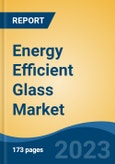Speak directly to the analyst to clarify any post sales queries you may have.
10% Free customizationThis report comes with 10% free customization, enabling you to add data that meets your specific business needs.
The primary types of energy-efficient glass include Low-E (low emissivity) glass, insulated glass units (IGUs), solar control glass, and smart or dynamic glass, all of which contribute to improved energy performance by reflecting heat, blocking ultraviolet rays, or controlling light transmission. The demand for energy-efficient glass has grown significantly in recent years, driven by stringent energy regulations and a global push for sustainability and environmental protection. The construction industry is a major end-user, with growing adoption in both residential and commercial buildings to meet green building standards and reduce energy costs. Additionally, the automotive industry is a significant consumer of energy-efficient glass, with increasing incorporation of smart windows in vehicles to enhance comfort, reduce fuel consumption, and improve overall efficiency.
Key Market Drivers
Increasing Demand for Energy Conservation and Sustainability
The growing emphasis on energy conservation and sustainability is a major driver for the Energy Efficient Glass Market. As global energy consumption rises and environmental concerns become more pressing, there is a significant push towards reducing energy consumption in buildings, automotive, and other sectors. Energy-efficient glass plays a critical role in achieving these sustainability goals, particularly in reducing heating, cooling, and lighting energy costs. By incorporating advanced coatings, films, and glazing technologies, energy-efficient glass can reduce heat transfer, block harmful UV rays, and provide better insulation, all of which contribute to reducing a building's carbon footprint.Governments and regulatory bodies around the world are increasingly adopting stringent building codes and energy standards that promote the use of energy-efficient materials in construction. For instance, the implementation of green building certifications, such as LEED (Leadership in Energy and Environmental Design), and policies such as tax incentives and subsidies for energy-efficient products have accelerated the adoption of energy-efficient glass. Additionally, industries are more conscious of their environmental impact, making the use of energy-efficient glass an attractive option for reducing operational costs and complying with environmental regulations.
Key Market Trends
Rising Demand for Green Building Standards and Sustainable Construction
The Energy Efficient Glass Market is experiencing a significant trend driven by the increasing adoption of green building standards and sustainable construction practices. As global concerns over climate change, energy consumption, and carbon emissions continue to rise, governments, architects, and builders are emphasizing the importance of energy-efficient designs. Energy-efficient glass, which helps to minimize heat loss, reduce energy costs, and enhance the comfort of indoor spaces, plays a crucial role in meeting these sustainability goals.Building regulations and certifications such as LEED (Leadership in Energy and Environmental Design) and BREEAM (Building Research Establishment Environmental Assessment Method) are pushing the construction industry toward incorporating energy-saving materials, including energy-efficient glass, into both commercial and residential buildings. This trend is further supported by the growing focus on energy-efficient retrofitting of existing buildings. As a result, architects and builders are increasingly opting for glass technologies that offer superior thermal insulation, solar control, and light transmittance, such as low-emissivity (Low-E) coatings, double or triple glazing, and spectrally selective glass.
In addition to reducing the environmental footprint, energy-efficient glass helps building owners reduce operational costs by cutting down on heating, cooling, and lighting expenses. This trend is anticipated to continue as the demand for environmentally friendly buildings grows, supported by government incentives, tax rebates, and stricter building codes.
Key Market Players
- Saint-Gobain
- AGC Inc.
- Nippon Sheet Glass Co., Ltd
- SCHOTT AG
- Guardian Industries
- PPG Industries Inc.
- DuPont de Nemours, Inc.
- Corning Incorporated
- Central Glass Co., Ltd.
- Taiwan Glass Industry Corporation
Report Scope:
In this report, the Global Energy Efficient Glass Market has been segmented into the following categories, in addition to the industry trends which have also been detailed below:Energy Efficient Glass Market, By Glazing:
- Triple Glazing
- Double Glazing
- Single Glazing
Energy Efficient Glass Market, By Coating:
- Hard Coat
- Soft Coat
Energy Efficient Glass Market, By Industry Vertical:
- Building & Construction
- Automotive
- Solar Panel
- Others
Energy Efficient Glass Market, By Region:
- North America
- United States
- Canada
- Mexico
- Europe
- France
- United Kingdom
- Italy
- Germany
- Spain
- Asia-Pacific
- China
- India
- Japan
- Australia
- South Korea
- South America
- Brazil
- Argentina
- Colombia
- Middle East & Africa
- South Africa
- Saudi Arabia
- UAE
- Kuwait
- Turkey
Competitive Landscape
Company Profiles: Detailed analysis of the major companies present in the Global Energy Efficient Glass Market.Available Customizations:
With the given market data, the publisher offers customizations according to a company's specific needs. The following customization options are available for the report.Company Information
- Detailed analysis and profiling of additional Market players (up to five).
This product will be delivered within 1-3 business days.
Table of Contents
Companies Mentioned
- Saint-Gobain
- AGC Inc.
- Nippon Sheet Glass Co., Ltd
- SCHOTT AG
- Guardian Industries
- PPG Industries Inc.
- DuPont de Nemours, Inc.
- Corning Incorporated
- Central Glass Co., Ltd.
- Taiwan Glass Industry Corporation
Table Information
| Report Attribute | Details |
|---|---|
| No. of Pages | 188 |
| Published | February 2025 |
| Forecast Period | 2024 - 2030 |
| Estimated Market Value ( USD | $ 15.63 Billion |
| Forecasted Market Value ( USD | $ 29.2 Billion |
| Compound Annual Growth Rate | 10.8% |
| Regions Covered | Global |
| No. of Companies Mentioned | 10 |









